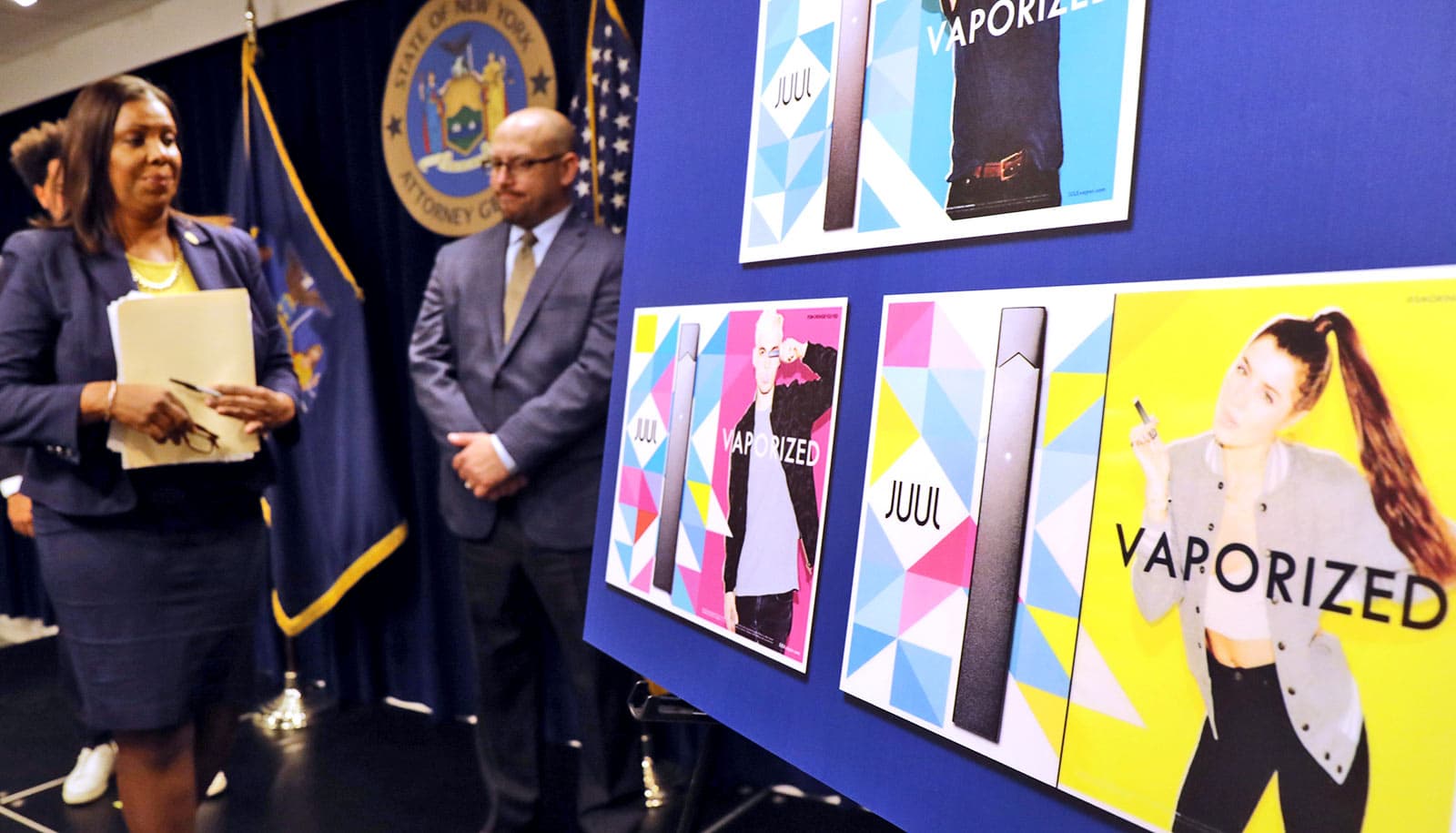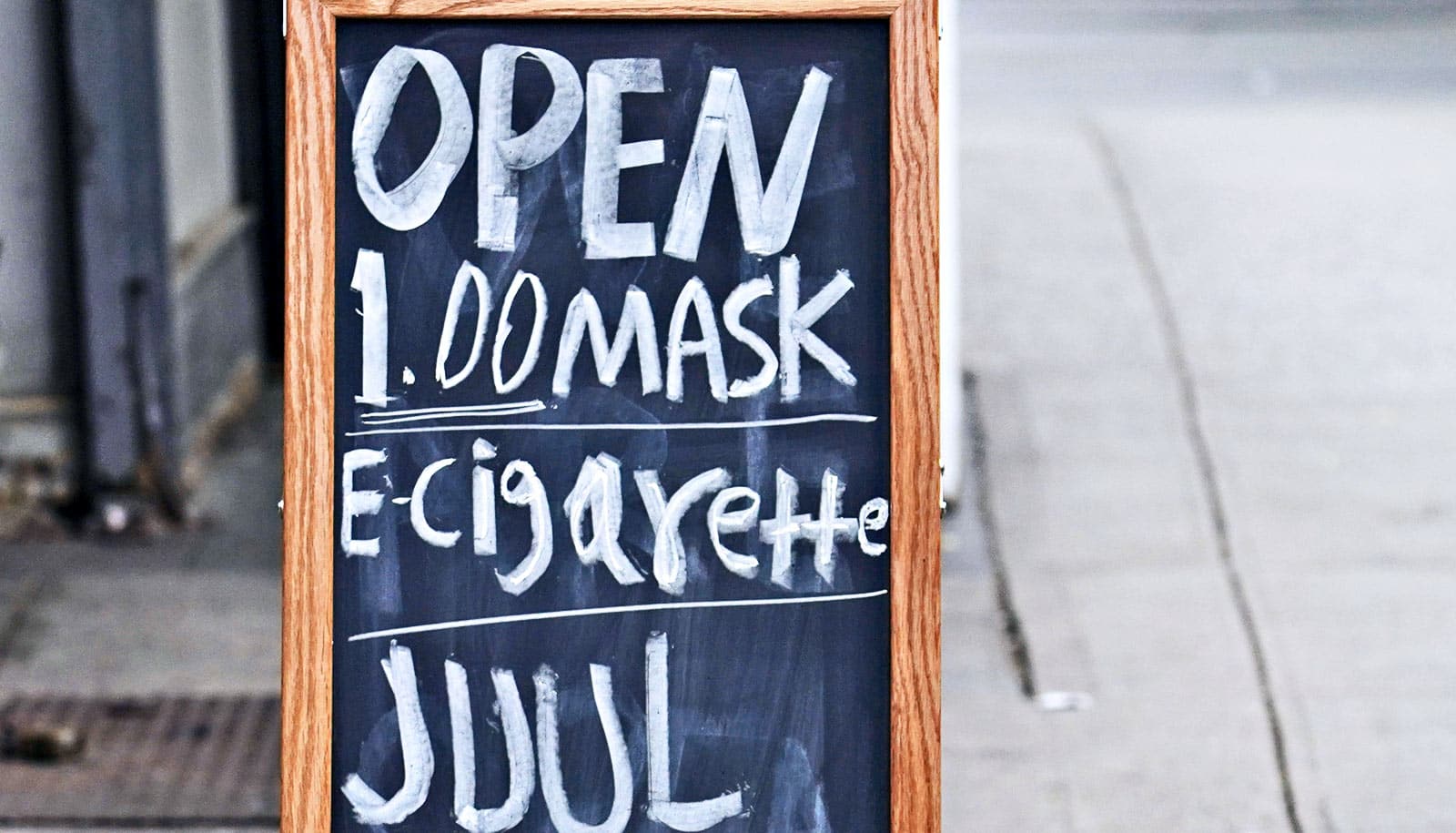
"The message about the dangers of smoking tobacco was just getting through, and then vaping came along and we may now have a whole new generation addicted to nicotine," says Tammy Chang. (Credit: Don Delfin Espino/Unsplash )
Survey: ‘Cool’ factor, not flavor, drives teens to vape
The social aspects of vaping drive teens and young adults to use Juul and other e-cigarettes, even though they know and understand the risks of doing so.
The social aspects of vaping drive young people to use Juul and other e-cigarette products, according to nearly two-thirds of teens and young adults in a new study.
Less than 5% said the availability of fruity flavors drives their use of e-cigarettes, and only 10% said that addiction does.
The findings, published in a research letter in JAMA Pediatrics , come from a text-message-based survey of teens and young adults between the ages of 14 and 24, from the University of Michigan’s MyVoice study .
Researchers conducted the survey before the 2019 epidemic of vaping-associated lung injury , and long before suggestions that COVID-19 might pose a greater risk to people who smoke or vape. It was also conducted before the federal ban on sales of all vaping products to people under the age of 21, and on the sale of fruit-flavored vaping pods, but not vaping liquids.
But it still sheds light on what kinds of messaging and interventions might help reduce e-cigarette use in in youths, says senior author Tammy Chang, an assistant professor of family medicine at Michigan Medicine, the University of Michigan’s academic medical center.
“It’s not just about the flavors, it’s about understanding the motivations for using these products, and their attitudes toward risk. They’re more savvy than we think they are, and they’re using it because it’s about being cool and about the experimentation that happens naturally in adolescence.
“Reducing teen and young adult use of these products, especially under current policies, will require an evidence-based approach.”
‘Lived experiences’ of youth and vaping
The survey used “ juuling ” as the term for the activity of using Juul and other e-cigarettes. It asked a nationally representative sample of teens and young adults four questions, and allowed them to answer however they liked. In all, 1,129 young people answered—92% of those who have volunteered to receive occasional text surveys from the MyVoice study.
In all, 79% of the respondents said they think juuling is dangerous, and another 7% said it might be. Nearly 72% believe it can lead to use of other substances, including cigarettes and other drugs, and one in four of the rest of the respondents said that people who juul already use other substances.
“For policymakers and public health officials who… think that bans on flavors will be the answer, these data show that ship has sailed.”
“These findings are critically important because it describes the lived experiences of youth related to Juul, which has been missing. This is the kind of information we need to create policies and programs that work. Youth are depending on us to do that,” says lead author Georgia Wood, an undergraduate student at the University of Michigan.
“For policymakers and public health officials who want to focus prevention and cessation messages on the health risks, or who think that bans on flavors will be the answer, these data show that ship has sailed,” Chang says. “We need to use what we now know about what drives youth behavior, and put teeth behind the enforcement of sales bans as we have with alcohol.”
Other research has shown that vaping spiked among young people in the past few years, just as smoking of cigarettes had gone down to record low levels, Chang says.
“The message about the dangers of smoking tobacco was just getting through, and then vaping came along and we may now have a whole new generation addicted to nicotine,” she says.
Penalize the sellers?
The study broke respondents up by age group. While 14- to 17-year-olds were somewhat more likely to have heard of Juul, 84% of the 18-24-year-olds had heard of it. Young respondents were also somewhat more likely to say that social factors were the main reason that people their age use e-cigarettes, but 58% of older respondents also said this.
The two age groups had about the same perceptions of danger from vaping, including nicotine intake, physical health effects, and addiction. The same was true for their opinions about whether vaping leads to use of other substances.
More research needs to be done on how to help young people cut down on or stop using e-cigarettes, Chang says, especially given the fact that nicotine replacement products like gums and patches aren’t approved for people under 18. In the meantime, young people can talk to health providers about whether those products are right for them.
More research is needed on the effects of bans on sales of vaping products to people under 21, and sales of flavored pods, Chang says —as well as on the effect of the COVID-19 pandemic on access to vape shops that sell the bulk liquids used in non-pod devices. So is more research on young people’s patterns of cigarette use after these changes, she adds.
Meanwhile, enforcement of those new rules will become more important, she says.
“As a society, we need to do the baseline job of cutting back on the potential supply of nicotine in all its forms to young people, while allowing adults who use vaping as a means of reducing cigarette use to continue to have access,” she says.
“We need to focus on penalizing those who sell these products to people under 21, in any setting and any form, so that we can keep an addictive drug out of the hands of adolescents who are naturally seeking to experiment as part of their development.”
At the same time, vaping-related messaging to young people as early as middle school should focus on social factors, Chang says. This could include positive identity development that focuses on individual strengths instead of the need to be cool or belong to a social group that emphasizes vaping.
“We need to start our conversations with youth from this perspective—and start [them] early,” she says.
The Michigan Institute for Clinical & Health Research and the University of Michigan funded the work.
Source: University of Michigan
The post Survey: ‘Cool’ factor, not flavor, drives teens to vape appeared first on Futurity .
Share this article:
This article uses material from the Futurity article, and is licenced under a CC BY-SA 4.0 International License. Images, videos and audio are available under their respective licenses.
Related Articles:
Teens who use Juul might not consider it vaping
March 6, 2020 • futurityTeens who vape face much higher risk of COVID-19
Aug. 14, 2020 • futurityLinks/images:
- https://doi.org/10.1001/jamapediatrics.2020.0491
- https://hearmyvoicenow.org/
- https://www.futurity.org/e-cigarettes-harmful-metals-aerosol-1686792/
- https://www.futurity.org/e-cigarette-ban-laws-public-health-2102942/
- https://www.futurity.org/juul-electronic-cigarettes-teenagers-surveys-2298992-2/
- https://www.futurity.org/pulegone-e-cigarettes-smokeless-tobacco-2161592/
- https://www.futurity.org/nicotine-smokers-cigarettes-1016202/
- https://www.futurity.org/electronic-cigarettes-vaping-health-2012722-2/
- https://labblog.uofmhealth.org/rounds/study-shows-new-focus-needed-anti-vaping-efforts-for-teens-young-adults
- https://www.futurity.org/vaping-teenagers-e-cigarettes-juul-2357692/
- https://www.futurity.org


